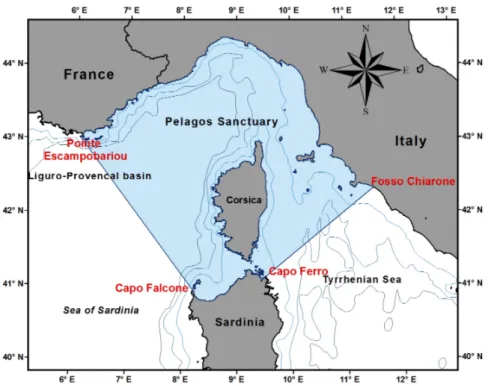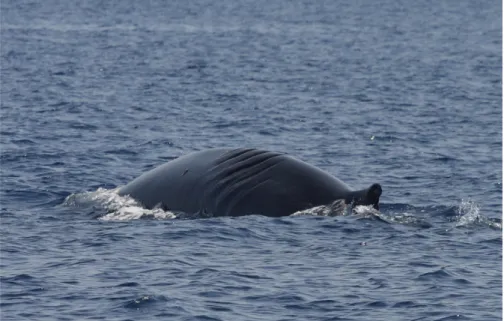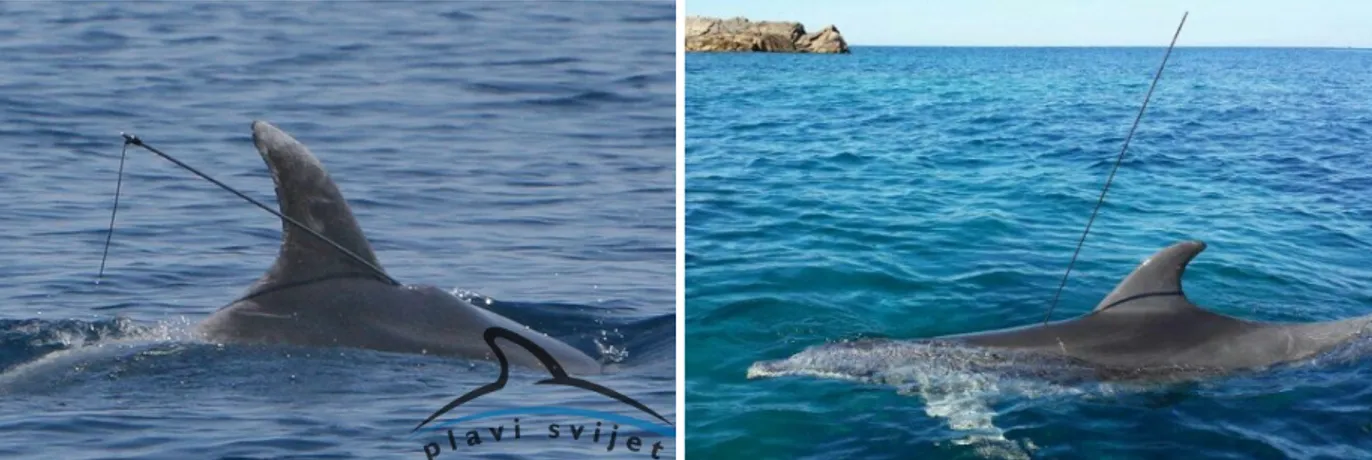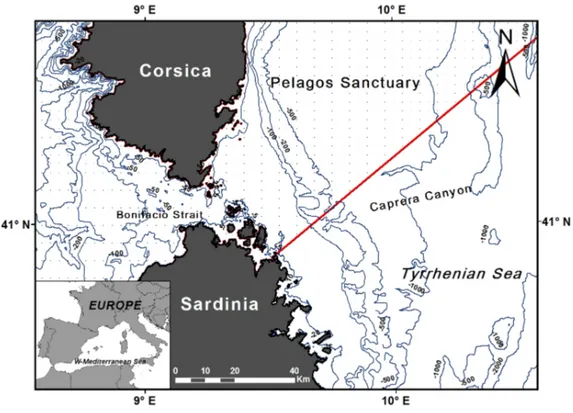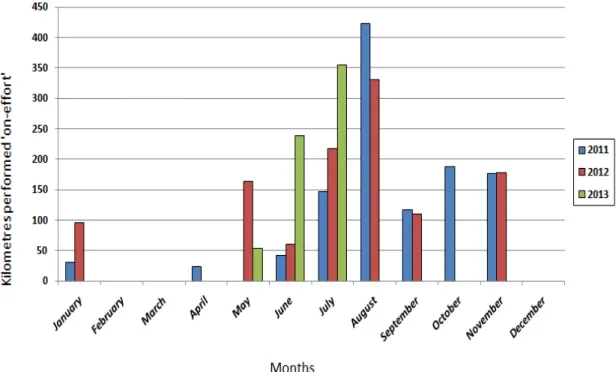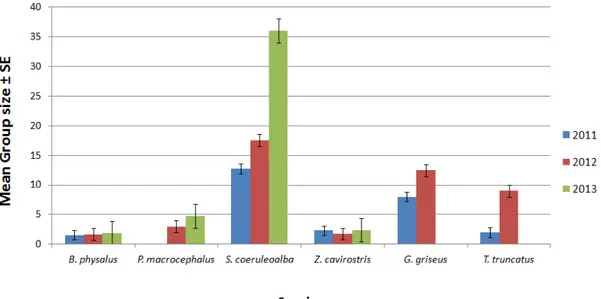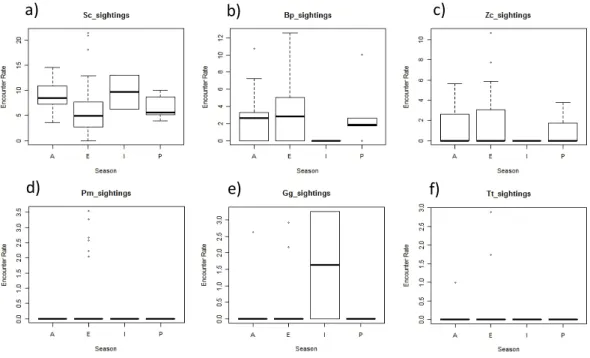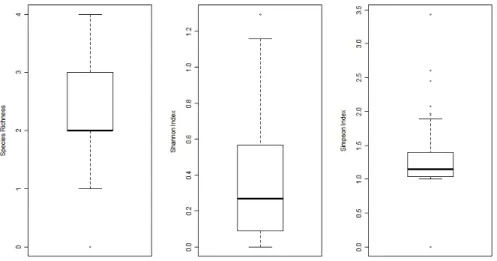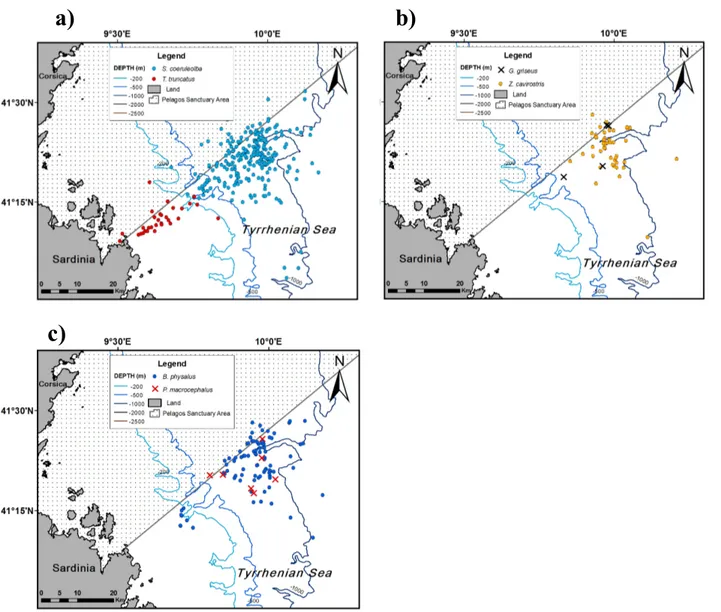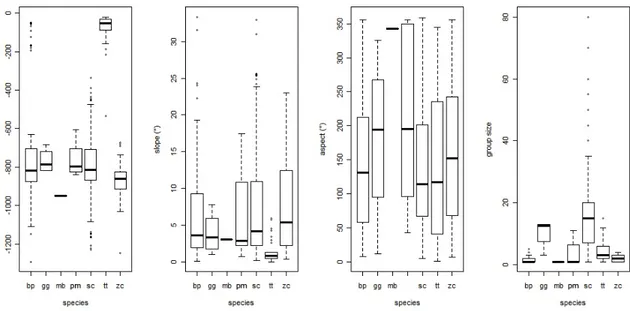University of Sassari Ph.D. School in Natural Sciences Via Muroni 25, I-07100 Sassari, Italy
Dissertation for the Degree of Doctor of Philosophy in Environmental Biology presented at Sassari University in 2013
XXV cycle
PELAGIC CETACEANS OFF NORTH-EASTERN SARDINIA AND
IMPLICATIONS FOR CONSERVATION
PH.D. CANDIDATE: Dr. Luca Bittau DIRECTOR OF THE SCHOOL: Prof. Marco Curini Galletti SUPERVISOR: Prof. Renata Manconi
University of Sassari Ph.D. School in Natural Sciences Via Muroni 25, I-07100 Sassari, Italy
Dissertation for the Degree of Doctor of Philosophy in Environmental Biology presented at Sassari University in 2013
XXV cycle
PELAGIC CETACEANS OFF NORTH-EASTERN SARDINIA
AND IMPLICATIONS FOR CONSERVATION
PH.D. CANDIDATE: Dr. Luca Bittau DIRECTOR OF THE SCHOOL: Prof. Marco Curini Galletti SUPERVISOR: Prof. Renata Manconi
I
NDEXABSTRACT
[E
NGLISH/
I
TALIAN]
page 2
INTRODUCTION
page 5
F
IRST PARTT
EMPORALLY AND SPATIALLY CHANGES IN CETACEANS DISTRIBUTION OFF NORTH-
EASTERNS
ARDINIAN COASTCHAPTER 1 - Occurrence, distribution and encounter rates of pelagic cetaceans around the Caprera Canyon (North-Eastern Sardinia, Western Mediterranean Sea)
page 34
CHAPTER 2 - Seasonal occurrence and distribution of fin whale (Balaenoptera physalus) and oceanographic variables off eastern Bonifacio Strait (central Tyrrhanian Sea)page 84
S
ECOND PARTP
RESENCE OF RARE AND CRYPTIC SPECIES:
S
OWERBY’
S BEAKED WHALECHAPTER 3 – How many mesoplodonts are in the Mediterranean Sea? First record of a free ranging Sowerby’s beaked whale (Mesoplodon bidens) in the Mediterranean Sea
page 131
T
HIRD PARTL
ARGE CETACEANS ENCOUNTERS AND BEHAVIOURAL DATA:
SPERM WHALE SOCIAL UNIT OFFN
ORTH-
EASTERNS
ARDINIACHAPTER 4 - Occurrence of sperm whale (Physeter macrocephalus) social units along the north-eastern Sardinian continental slope (Central Tyrrhenian Sea)
page 151
A
CKNOWLEDGEMENTS[E
NGLISH/
I
TALIAN]
page 164
University of Sassari Ph.D. School in Natural Sciences Via Muroni 25, I-07100 Sassari, Italy
SUMMARY
[ENGLISH] The all-year-round knowledge on cetaceans off Sardinia is scarce and
mostly focused on the coastal species Tursiops truncatus in the northern waters of the island. This work aims to increase information on pelagic cetaceans in the poor studied off-shore waters from North-Eastern Sardinian coast on the basis of surveys carried out between 2010 and 2013, using dedicated and opportunistic surveys.
First I evaluate the occurrence of pelagic cetacean species, the spatial-temporal distribution and the interactions with fixed physical variables (depth, slope and shape), non-fixed environmental variables (Sea Surface Temperature and chlorophyll a) which may affect their presence and distribution in the study area. The relative abundance of the cetacean species regularly inhabiting the area and the high encounter rate values, point out the significance of the Caprera Canyon for the cetaceans’ conservation, in the central Tyrrhenian Sea. Therefore I analyzed the occurrence and seasonal distribution of Balaenoptera physalus the only Mysticete in Mediterranean Sea, in relation with oceanographic variables as Sea Surface temperature and chlorophyll a. The high seasonal presence of fin whale off north-eastern Sardinia reflects a yearly pattern and is linked to a mix of variables such as the bottom features, water circulations as proxy of prey availability.
Moreover, I analyzed the sightings of three social units of Physeter macrocephalus recorded during summer 2010 and 2013. The encounter rates of this species in the entire study period were low. Despite this I recorded three encounters with sperm whale pods that highlighted the periodic use of the Caprera Canyon by these large cetaceans. The social units were composed of several individuals such as females, calves and probably young males. Finally I present the first documented records of a free-ranging Sowerby’s beaked whale (Mesoplodon bidens) in the Mediterranean Sea. This rare and elusive cetacean was sighted together with three Cuvier’s beaked whales in a mixed species group. Scarring observed on the whale’s flanks may result from interspecific interaction with males of Cuvier’s beaked whales. Nevertheless, all the gathered data suggest that the mesoplodont in the Tyrrhenian Sea could be considered as a stray.
RIASSUNTO
[ITALIAN] Le conoscenze estese a tutto l’arco dell’anno sulla fauna a cetacei al largo delle
coste della Sardegna sono scarse e si sono focalizzate fino ad ora soprattutto sulle specie costiere. Questo lavoro si propone di incrementare le conoscenze sui cetacei pelagici nelle acque off-shore della costa nord-orientale della Sardegna.
Inizialmente ho valutato la presenza/assenza di cetacei pelagici nell’area di studio nell’arco di tre anni, la distribuzione spazio-temporale e le interazioni con le variabili fisiche fisse (profondità, pendenza ed esposizione) e le variabili ambientali non fisse (temperatura superficiale del mare e clorofilla a) che possono influenzare la presenza/assenza e la distribuzione geografica. L'abbondanza relativa delle specie di cetacei che frequentano regolarmente la zona, sottolineano l'importanza del Canyon Caprera per la conservazione dei cetacei nel Mar Tirreno centrale. Successivamente ho analizzato la presenza/assenza e la distribuzione geografica stagionale di Balaenoptera physalus l'unico misticete regolarmente avvistato nel Mar Mediterraneo, in relazione con le variabili oceanografiche come temperatura superficiale del mare e clorofilla a. L'elevata presenza stagionale di balenottera comune al largo della Sardegna nord-orientale riflette un modello annuale ed è legata a un insieme di variabili fisiche e oceanografiche quali, per esempio, fattori trofici in relazione alla disponibilità di risorse alimentari. Inoltre, ho analizzato gli avvistamenti di tre ‘unità sociali’ (social unit) di Physeter macrocephalus avvistate durante l'estate degli anni 2010 e 2013. I tassi di avvistamento di capodoglio in tutto il periodo di studio sono stati bassi. Nonostante questo ho registrato tre incontri con gruppi sociali di questa specie che hanno evidenziato l' uso periodico del Canyon di Caprera da parte di questi grandi cetacei. Le social unit erano composte da diversi individui, come femmine, piccoli e probabili giovani maschi. Infine ho documentato il primo avvistamento di un mesoplodonte di Sowerby (Mesoplodon bidens) in ambiente libero nel Mar Mediterraneo. Il raro cetaceo è stato avvistato insieme a tre zifi in un gruppo misto. Le cicatrici osservate sul corpo del mesoplodonte possono essere attribuite a un'interazione interspecifica con maschi di zifio. Tuttavia, al momento tutti i dati raccolti suggeriscono che il mesoplodonte nel Mar Tirreno potrebbe essere considerato come un avvistamento occasionale.
INTRODUCTION
This thesis consists of three main parts dealing with presence/absence, geographic distribution and behaviour of pelagic cetacean species off the North-eastern Sardinia Island. In the First Part I evaluate the influence of environmental conditions on the occurrence of pelagic cetaceans around the Caprera Canyon area, in relation to time, space and environmental covariates. Focus on fin whales was treated separately, to deepen any temporal discontinuity of their presence in the study area and relation to environmental covariates. In the Second Part I analyze the presence of rare, cryptic and inconspicuous species as in the case of the Sowerby’s beaked whale, recorded in a mixed species group and representing the first live record in the Mediterranean Sea. Finally, in the Third Part, I report the occurrence and behaviour of sperm whale social units off North-eastern Sardinia, a poor studied area for both toothed and baleen whales.
The rich and unique biodiversity of the Mediterranean Sea has led to its recognition as one of the most important biodiversity hotspots on a global scale (Medail & Quezel, 1999; Myers et al., 2000; IUCN, 2012). Despite its oligotrophy, a combination of different environments, sea bottoms and oceanographic features, supports high values of abundance and diversity of marine wildlife including cetaceans, which live in and migrate through the different basins.
Of the ca. eighty-seven living species of cetaceans, infraorder Cetacea (14 species of baleen whales, Mysticeti Flower, 1864 and 73 species of toothed whales, dolphins and porpoises, Odontoceti Flower, 1867) (www.marinemammalscience.org - 2013) nineteen have been recorded in the Mediterranean Sea, none of which is endemic. Eight species are common in the Western Mediterranean Sea, four are only occasional, that is not regularly present, and seven are accidental, rarely entering the Mediterranean basin.
Among the eight regular species occurring in the Western Mediterranean, seven are odontocetes: common bottlenose dolphin Tursiops truncatus (Montagu, 1821); striped dolphin Stenella coeruleoalba (Meyen, 1833); short beaked common dolphin Delphinus
delphis Linnaeus, 1758, long-finned pilot whale Globicephala melas (Traill, 1809); Risso’s
1823; sperm whale Physeter macrocephalus Linnaeus, 1758, and a single species of mysticetes: the fin whale Balaenoptera physalus (Linnaeus, 1758).
Other two cetacean species, the rough-toothed dolphin Steno bredanensis (G. Cuvier in Lesson, 1828) and the false killer whale Pseudorca crassidens (Owen, 1846), were formerly considered visitors of the Mediterranean. At present, stable small resident populations that are not transient visitors have been tentatively recognized for both species in the Eastern Mediterranean (Levantine Basin) as a result of frequent sightings and strandings in this area (Boisseau et al., 2010; IUCN, 2012; Kerem et al., 2012). It is clear that new, further investigations will be needed to draw a more accurate assessment on the occurrence of these two species. In the 1980s cetacean researchers were surprised to find populations of several species of whales and dolphins living in the Mediterranean Sea close to tourist/industrial hot spots along the Spanish, French and Italian coasts and the Greek Islands, even though busy shipping traffic, pollution problems and exotic marine species (Hoyt, 2005).
Despite the Western Liguria was called in Roman times Costa Ballaenae, the ‘Coast of whales’ (Orsi Relini et al., 1992), such ancient cultural heritage became lost for centuries, and until very recently the large whales were considered rare and accidental in the Mediterranean even by esteemed marine zoologists (Tortonese, 1965). Since the early 90s, studies on cetacean populations in the western basin revealed the importance of the Corso-Ligurian Basin as one of the pelagic areas with highest cetacean densities in the entire Mediterranean Sea (Notarbartolo di Sciara et al., 1993; Forcada et al., 1995).
The Corsican–Ligurian–Provencal basin and particularly the Ligurian Sea are probably the most productive pelagic waters of the entire Mediterranean Sea. Interaction of climatic, oceanographic and physiographic factors enables these areas to support high levels of primary productivity, and to harbour a richer cetacean fauna than neighbouring marine regions (Notarbartolo di Sciara et al., 1993).
The relevant primary productivity in the Corsican-Ligurian Basin is due to the presence of a permanent frontal system, and resulting upwelling of deep, nutrient-rich waters, unlike most of the Mediterranean pelagic waters. The large biomass of the Mediterranean euphausiid, Meganyctiphanes norvegica (M. Sars, 1857) together with cephalopods and fishes, supports the occurrence of eight species of cetaceans including fin, sperm, Cuvier’s beaked, long-finned pilot whales, striped, Risso’s, bottlenose, and
shortbeaked common dolphins. The Mediterranean habitats of these pelagic cetaceans lie largely in international waters (Ardron et al., 2008; Notarbartolo di Sciara et al., 2008). The largest cetacean species occurring in the Mediterranean, the fin whale B. Physalus, congregate in the Ligurian Sea in high densities during summer, which is known to be the species’ feeding season. Thus the fin whales summering in this area are strongly correlated with prey availability (Orsi Relini et al., 1992, 1994; Relini et al., 1994), moreover food availability is probably the main key factor of space use by marine mammals (e.g. Benoit-Bird & Au 2003; Friedlaender et al., 2006).
Towards the establishment of a Sanctuary for the protection of Mediterranean marine mammals
Based on the significant presence of cetacean species in the Corsica and Ligurian seas, France, Italy and Monaco agreed to establish in 1999 an International Sanctuary for the Protection of Mediterranean Marine Mammals also known as the “Pelagos Sanctuary”, the largest Mediterranean Marine Protected Area and the world’s first international high-sea MPA (Marine Protected Area). It was established as a sanctuary for marine mammals to manage the negative impacts of human activities and to protect marine mammals against all causes of disturbances and threats (Adron et al., 2008; Notarbartolo di Sciara et al., 2008). In fact, this faunal diversity coexists with very high levels of human pressure since ancient times, resulting from various human activities causing actual and potential threats to cetacean populations.
The Pelagos Sanctuary was established on 25 November 1999, covering areas of the Mediterranean seas of France, Italy, and the Principality of Monaco (Notarbartolo di Sciara
et al., 2008; Hoyt, 2009).
The Sanctuary encompasses an area of 33,772 square miles (87.492 km2) between
Southeastern France, Monaco, Northwestern Italy, Northern Sardinia, and surrounding Corsica and the Tuscan Archipelago, also including a strait, the Strait of Bonifacio between the islands of Corsica and Sardinia. With a coastline of over 2,000 linear km, more than 270 km belong to the North of Sardinia coastline, where two National Parks there are: the Asinara and The La Maddalena Archipelago national Parks. In 2001, the high seas agreement was listed under the Barcelona Convention, making Pelagos a Special Protected Area of Mediterranean Importance (SPAMI) which confers the official protection of all signatory
Mediterranean countries in both national waters and on the high seas (Hoyt, 2005; Notarbartolo di Sciara et al., 2008). Although the Pelagos Sanctuary agreement came into force in 2002 ratified by all three member states, it came up to speed and to function as a valuable conservation tool up to 2013. However eleven years after ratification the effective conservation measures are still few. Especially within the Pelagos Sanctuary area dedicated visual and acoustic research cruises from ship-based transects grew mostly in the Corsican-Ligurian-Provençal basin, focusing more extensive studies in the Ligurian Sea than in other sectors of the Western Mediterranean (e.g. Notarbartolo di Sciara et al., 2003, 2008; Moulins & Wurtz, 2005; Panigada et al., 2005, 2008; Laran & Drouout-Dulau, 2007), reinforcing the preliminary studies carried out before the establishment of the Sanctuary (e.g. Relini et al., 1992; Orsi Relini & Giordano, 1992; Notarbartolo di Sciara, 1994a; Orsi Relini et al., 1994; Forcada et al., 1995; Forcada et al., 1996; Gordon et al., 2000). Despite the notable research effort only a few studies were carried out on a larger scale (e.g. Notarbartolo di Sciara et al., 1993).
Fig. 1 The Pelagos Sanctuary area. Sardinia has more than 270 km of coastline within the area of the Sanctuary
Cetacean threats and conservation in the Mediterranean Sea
The Mediterranean cetacean subpopulations must cohabit with very high levels of human pressure. About this, the Pelagos Sanctuary area is characterized, as well as the highest density of cetaceans, by the highest risk of collision of the entire Western Mediterranean basin (Panigada et al., 2006).
The coastal areas bordering on the Sanctuary are greatly populated and disseminated with urban, industrial and military settlements as well as commercial and tourist ports. These latter add a pressure load in the summer months of the tourist season, due to important tourist destinations (Notarbartolo di Sciara et al., 2008).
As a consequence, a range of human activities in the Sanctuary area causes several real and possible threats to cetacean populations, such as habitat degradation, regression and destruction caused by urban, tourist, industrial, and agricultural development, also associated with pollution close to the larger ports and river mouths. High disturbance can be due to the intense maritime traffic (e.g. from passenger, cargo, fishing and pleasure vessels), particularly in summer, as well as to unregulated whale watching industry, military exercises and seismic oil and gas prospection. A growing risk of collision with vessels, also related with the increase of high-speed passenger transportation can cause mortality as well as the accidental entanglement in pelagic driftnets, which continue to be used in the area in spite of a ban on driftnetting imposed on fleets of European member states (Notarbartolo di Sciara et al., 2008).
Recent studies pointed out that the Sanctuary, the Gulf of Lions and the adjacent waters are high-risk areas for fin whale collisions. In the western Mediterranean, the Pelagos Sanctuary waters are also among the busiest of the entire Mediterranean basin. As a consequence, the fatal collision mortality rate for B. physalus here is three times higher than for the whole western basin (Panigada et al., 2006).
The 82.2% of collisions between whales and ships is within the Pelagos Sanctuary boundaries, 6.7% in the Tyrrhenian Sea, and 11.1% in the Alboran Sea/Balearic basin and the Sardinian Sea (Panigada et al., 2006). The presence in the North-eastern Sardinia of two busiest Tyrrhenian commercial ports (Olbia and Golfo Aranci) and several tourist harbours generates an intense commercial, cargo and recreational maritime traffic that intensify in the summer, due to the high tourist appeal of the Sardinia and Corsica islands and their
archipelagos, making this area one of the busiest of the entire Western Mediterranean. The intensity of maritime traffic carries the risk of collisions with large cetaceans or may cause abandoning of habitat as a result of disruption caused by human activities.
Pollution can cause severe threat to the health of marine ecosystems and cetaceans in particular, as they represent ‘top predator’ affected by bioaccumulation and biomagnification of toxic elements. For example, striped dolphins in the Pelagos Sanctuary are subject to greater toxicological stress than other Mediterranean cetacean populations. Particular concerns arise from the evidence that 50% of the striped dolphins from the Pelagos Sanctuary were classified in the high toxicological hazard group (Fossi et al., 2013). Aguilar et al. (2002) and Marsili et al. (2004) detected ecotoxicological gender differences: 70.6% of females striped dolphins were classified in the low toxicological risk group and 32% and 44% of males were classified in the moderate and high groups, respectively, confirming that male cetaceans are subject to higher toxicological risk.
Fossi et al. (2013) clearly highlighted the effectiveness of MPAs describing the first evidence of toxicological stress in cetaceans living in the only Mediterranean pelagic MPA of the Mediterranean Sea: the Pelagos Sanctuary. Protecting Pelagos Sanctuary’s marine biodiversity requires active management to prevent, control or eradicate environmental threats. This should include developing and delivering programs and activities that efficiently and effectively use available resources to achieve desired environmental outcomes. However, in the 13 years since its establishment Pelagos has partially failed to fulfill its goal of significantly improving the conservation status of the area’s cetacean populations (Fossi et
al., 2013).
Out of the Pelagos, an increasingly ‘tight’ boundary for the cetacean conservation in the Mediterranean Sea, recently Italy established an Ecological Protection Zone (EPZ) in its Tyrrhenian, Ligurian and Sardinian waters (D.P.R. 209/2011). This EPZ follows and joins the adjacent French EPZ, declared in 2004, allowing Italy to extend Italian (and EU) regulations to much larger areas under its sovereignty and enforcing the measures so far, applicable only in Italian territorial waters. Among the primary objectives of the new established EPZ, there is the protection of marine biodiversity and ecosystems with a specific reference to marine mammals. The first significant consequence for cetacean conservation is that most marine waters of the Pelagos Sanctuary now lie within the jurisdiction of either France or Italy, extending their jurisdiction beyond their strict territorial waters as provided by UNCLOS - the
United Nations Convention on the Law of the Sea (Hoyt, 2005). This will greatly facilitate the implementation of management measures in the Sanctuary, which are so important for many of the region’s cetacean populations, removing a psychological barrier that until now has prevented from considering Pelagos a “real” MPA (www.ciesm.org; www.accobams.org). Many cetacean species, including sperm, beaked, other toothed whales and large baleen whales spend part or even most of their life cycles in pelagic waters, off the continental shelves and far from the coasts. Large areas of their critical habitats may be in the 50% of the world ocean classed as international waters, or high seas, outside the limits declared by most countries under the UNCLOS Convention (Hoyt, 2009). In such areas, where no single state or authority has the power to establish MPAs, adopt management schemes, or enforce compliance, new strategies must be designed to protect and manage high seas habitats (Thiel & Koslow, 2001; Hoyt, 2009).
In this study, I highlighted how research on marine mammals in areas outside the already established Marine Protected Areas, often poor or unknown, are critical for the conservation and management of cetacean populations in the Mediterranean Sea.
Fig. 2 A fin whale enjuried from a medium-size propeller, photographed in
summer 2011, during the field work carried out for this PhD thesis. Fatal ship strikes are the higher threat for large cetaceans.
Cetacean subpopulations in the Mediterranean Sea and conservation
The knowledge of pelagic cetaceans’ eco-ethology at the Mediterranean sub-population level is scarce and at present both short- and long-distance movements of individuals/groups are poorly known within the entire basin, and among sub-basins. Although the IUCN (International Union for the Conservation of Nature) Red List assessment of Mediterranean resident cetacean species classifies the conservation status as ‘Data Deficient’ for three sub-populations in the basin (Z. cavirostris, G. griseus, and G. melas) it is a general opinion that Mediterranean cetacean populations are at risk.
Despite eight cetacean species are considered as ‘regular’ in the Mediterranean Sea and their IUCN classification criteria varies from Least Concern to Vulnerable, the poor knowledge on the Mediterranean cetacean populations size led to lack of absolute abundance estimates and the impossibility of define the certain conservation status.
S. coeruleoalba is the most abundant cetacean throughout Mediterranean offshore
waters (Aguilar, 2000) with an estimated summer population size of 20,000–30,000 individuals (Forcada et al., 1995) within the area of the Corsican–Ligurian–Provencal basin. Fin whale and striped dolphin are even the two most abundant cetaceans in the Pelagos Sanctuary area and represent, respectively, 20% and 60% of all historical (1986–1989) summer-time cetacean sightings (Notarbartolo di Sciara, 1994). Presently, the striped dolphin in the Mediterranean Sea is classed as ‘Vulnerable’, under the IUCN criteria (Reeves & Notarbartolo di Sciara 2006; Notarbartolo di Sciara & Birkun, 2010) (Tab. 1). In the past, many striped dolphins were hunted for their meat, which was used as bait for shrimp traps and long lines. It was recently reported that in Italy striped dolphin meat trade continues illegally, despite the legal risks to sell meat of protected animals such as cetaceans, either by-catched or intentionally killed.
The striped dolphin is primarily threatened by habitat degradation caused by agricultural pesticides and antifoulants, water pollution and commercial fisheries (Aguilar & Gaspari, 2012 in www.iucnredlist.org). A disease outbreak in 1990–1992, caused by a morbillivirus, devastated a large proportion of the population, causing many deaths (IUCN, 2012). Starting from January 2013, preliminary studies on an unusual frequency of striped dolphin strandings along the Italian coasts of the Tyrrhenian Sea suggested an infectious agent. Now it is clear that the dramatic outbreak that occurred in the Tyrrhenian Sea striped
dolphin population from January to April 2013 was again due to Dolphin Morbillivirus (DMV) which caused at least four epidemics in the Western Mediterranean during the last 20–25 years. These epidemics may dramatically impact the health and conservation of striped dolphins living in this area (Di Guardo & Mazzariol, 2013). Lethal cases of DMV infection has recently affected even two individuals of fin whale stranded along the Tyrrhenian coast of Italy (Di Guardo & Mazzariol, 2013).
Regarding B. Physalus, about 3,500 individuals are recorded in the western Mediterranean (Forcada et al., 1995) and a large proportion of these gather in the Corsican– Ligurian–Provencal basin in summer to feed on krill (Forcada et al., 1996), although they can be observed in this area all the year round (Notarbartolo di Sciara et al., 2003). Recently the estimate of the fin whale in the western Mediterranean needs to be revised downward, due to the presence of occasional immigrant whales from the Eastern North Atlantic Ocean into the Western Mediterranean (Castellote et al., 2011). Currently, the fin whale is classed as ‘Vulnerable’ at the Mediterranean basin level (Tab. 1). The biggest threats to fin whales are disturbance by ship, including the increasing use of high-speed ferries, recreational vessels and by seismic airguns. The high-speed ferries are not yet sufficiently investigated. For example, the latest passenger ships connecting Sardinia to the Italian mainland, can reach speeds close to 30 knots, crossing the Pelagos Sanctuary area and the study area that I investigated in this study. Human-induced mortality of fin whale is due to vessel collisions and by-catch in fishing gear (Panigada et al., 2006). Panigada et al. (2006) made a review of the known collision events that affected fin whales: many whales have been brought into the port on the ship’s bow and several occurred in Sardinia (Olbia, Golfo Aranci and Porto Torres).
Fossi & Marsili (2003) and Fossi et al. (2004a, 2012) described high levels of contamination by organochlorines, trace elements and DDT metabolite values in Mediterranean fin whales and suggested that their estrogenic and anti-androgenic effects may negatively influence the population.
The six other cetacean species are a regular component of the Pelagos Sanctuary cetacean fauna (Notarbartolo di Sciara et al., 2008). Deep-diving squid-eating odontocetes such as sperm whales, long-finned pilot whales and Risso’s dolphins, occur both offshore and continental slope waters (Di Meglio et al., 1999; Gordon et al., 2000; Bearzi et al., 2010). Cuvier’s beaked whales show habitat preference for continental slopes (Cañadas et al., 2002;
Moulins et al., 2007). The now rare and endangered short-beaked common dolphins prefer both coastal and offshore waters mostly in the southern sector of the Pelagos Sanctuary (Bearzi et al., 2003). Bottlenose dolphins frequent mainly coastal habitats as the shelf areas surrounding Corsica, northern Sardinia, the Tuscan Archipelago and continental France (Bearzi et al., 2009; Gnone et al., 2011).
Despite being the most common species of dolphin in coastal habitat, there is no overall estimate of the Mediterranean population of T. truncatus. Little information exists on the geographic range, especially in the Levantine and Southern Mediterranean basins. The total Mediterranean population may be in the low 10,000s, based on observed densities in surveyed areas (Bearzi et al., 2008). Further subpopulation structure exists and may require future assessments at a finer geographical scale (Bearzi et al., 2012 in www.iucnredlist.org). An overall decline in the population seems likely, however, as in those regions where regular monitoring takes place, there has been a stable decrease in the areas where they are observed as well as reductions in their range and abundance (possibly by more than 30% since 1940) (IUCN, 2012).
The northern Adriatic Sea is the only Mediterranean area with quantitative historical information that can be used to infer population trends over time scales of more than two decades. There, common bottlenose dolphin numbers are considered to have declined by at least 50% over the last 50 years, initially as a consequence of deliberate killing by the fishing industry, followed by reduced food availability caused by overfishing and environmental degradation (Bearzi et al., 2004; IUCN, 2012).
Intentional killing still continue, although less than in the past, as evidenced by episodes of bottlenose dolphins injured, killed or hit with harpoon for underwater fishing in August, 2013 both in Croatia (Olib island, the dolphin survived) and Sardinia (Archipelago of La Maddalena, the dolphin died due to the wound) (Fig. 1). In both areas studies on dolphins are regularly but recently performed while professional and sport fishing represent a long tradition. Coexistence between bottlenose dolphins and fisheries is still difficult, as evidenced by these few, known episodes.
For some other areas of the northern Mediterranean (e.g. in Italy and southern France) the available information is less precise but suggests similar decreasing trends (Blanco & González 1992; Borrell et al., 2007). Off southern Spain, where this species has been studied intensively, abundance estimates have shown variability but no trend since the early 1990s (Cañadas et al., 2006).
Mediterranean common bottlenose dolphins are, at present, classed as ‘Vulnerable’ according to the IUCN Red List criteria (Bearzi et al., 2012 in www.iucnredlist.org). Since 2006, the year of this proposed classification, was based primarily on suspected population declines caused by (i) direct kills and extermination campaigns conducted until at least the early 1960s in portions of the basin and (ii) recent and ongoing incidental mortality in fishing gear (generally known as ‘by-catch’) (Bearzi et al., 2008). The major threats that currently put the survival of the species at risk are the competition with commercial fisheries, by-catch in driftnets and water pollution causing the accumulation of toxins in their bodies from chemical pollution (Bearzi et al., 2008; IUCN, 2012).
D.delphis, once a very common Mediterranean species, has declined by more than
50% in the past 30–45 years. Literature and osteological collections unambiguously confirm that common dolphins were widespread and abundant in large areas of the Mediterranean Sea until the late 1960s, and that their decline occurred relatively quickly (Bearzi et al. 2003). However, there is very limited information on population size and trends for this species and there is no basin-wide estimate of abundance for Common Dolphins at Mediterranean Sea level. The species is today relatively abundant in the Alboran Sea, off western Sardinia, in the Sicily Channel around Malta, in the eastern Ionian Sea, in the Aegean Sea, and off Israel
Fig. 3 August 2013: a) Bottlenose dolphin harpooned and survived near the island of Olib in the Vir Sea (Croatia)
(www.blue-world.org); b) bottlenose dolphin harpooned with a long Tahitian spear close to Razzoli Island, Archipelago di La Maddalena (Italy) (www.lamaddalenapark.it). The latter dolphin died due to the wound. Both cases have occurred within or in the vicinity of Marine Protected Areas.
(Levantine basin); whereas it has apparently vanished from many areas including the Adriatic Sea, Balearic Sea, Provençal basin and Ligurian Sea and is scarce for the central Tyrrhenian Sea (Notarbartolo di Sciara et al., 1993; IUCN, 2012). An estimate of 14,736 (CV=0.38; 95% CI=6,923) derived from line-transect ship surveys of the Alboràn Sea (1991-1992) with a density of 0.16 dolphins/km², but the low number of sightings not allowed estimates for this species elsewhere in the western Mediterranean (Forcada & Hammond, 1998).
As with many cetacean species, little is known about their presence in the waters along the North African coast. The species is currently listed as ‘Endangered’ in IUCN 2013 Red List (Bearzi, 2003 in www.iucnredlist.org).
The decline in numbers of Common Dolphins in the Mediterranean could be a consequence of prey depletion by commercial fisheries, by-catch in gillnets (drift gillnets), habitat degradation, noise pollution, environmental changes and high loads of pollutants, including accumulation of PCBs and heavy metals, which are thought to cause immune suppression, reproductive impairment and ultimately death (Bearzi, 2003 in www.iucnredlist.org).
No estimate of P. macrocephalus population size exists for the Mediterranean Sea. The total number of Mediterranean sperm whales in the whole Mediterranean basin amounts to only a few hundred individuals (Notarbartolo di Sciara et al., 2012, in www.iucnredlist.org). However, at least until the 1950s, there is evidence that sperm whales were once common in some Mediterranean areas, such as the Strait of Messina and the Aeolian Islands (coast of Sicily) where they could be seen in large groups of as many as 30 individuals, while nowadays such sightings are rare (IUCN, 2012).
Recently, the sperm whale classification was changed in ‘Endangered’, under the IUCN criteria (Reeves & Notarbartolo di Sciara, 2006; Notarbartolo di Sciara & Birkun, 2010). Over the last decade a considerable decline in the number of individuals in the region was pointed out by increasingly frequent reports of annual strandings (stranded, floating dead or entangled individuals) from France and Italy. Entanglement in fishing gear (especially swordfish drift gillnets and tuna driftnets), vessel strikes and disturbance by intense boat and ship traffic are the primary causes of the sperm whale endangered conservation status.
Tab. 1 IUCN (International Union for Conservation of Nature) Conservation status and international agreements, concerning marine mammals of the Mediterranean and Black Seas.
The IUCN Red List Criteria: EX: Extinct, EW: Extinct in the Wild, CR: Critically Endangered, EN: Endangered, VU: Vulnerable, NT: Near Threatened, LC: Least Concern, DD: Data Deficient, NE: Not Evaluated. Abbreviations HD: European Union Habitats Directive; CMS: Convention on the Conservation of Migratory species of Wild animals (Bonn Convention); BCCEW: Convention on the Conservation of European Wildlife and Natural Habitats (Bern Convention); BARCOM: Convention for the Protection of the Marine Environment and the Coastal Region of the Mediterranean (Barcelona Convention); CITES: Convention on International Trade in Endangered Species of Wild Fauna and Flora (IUCN, 2012). * Species not evaluated at regional level, but whose regional category coincides with the global one (endemic species); ** Roman numerals indicate the Annexes/Appendices where the species are listed.
FAMILY SCIENTIFIC NAME COMMON ITALIAN NAME
IUCN RED LIST CATEGORY AND CRITERIA
RELEVANT INTERNATIONAL AGREEMENTS FOR THE PROTECTION OF WILDLIFE IN THE MEDITERRANEAN AND BLACK SEAS**
Global Mediterranean Black Sea Category Criteria Category Criteria Category Criteria
PINNIPED Phocidae *Monachus monachus foca monaca CR C2a(i); E A2abc; CR C2a(i); E A2abc; HD: II-IV / CMS: I-II/ BCCEW: II/ BARCOM: II / CITES: I
CETACEANS
Balaenopteridae Balaenoptera physalus balenottera comune EN A1d VU C2a(ii) HD: IV / CMS: I-II / BCCEW: II / BARCOM: II / CITES: I
Delphinidae
Delphinus delphis delfino comune LC EN A2abc HD: IV / CMS: I-II / BCCEW: II / BARCOM: II / CITES: II
*Delphinus delphis ponticus
delfino comune
del Mar Nero VU A2cde VU A2cde HD: IV / CMS: II / BCCEW: II / BARCOM: II / CITES: II
Globicephala melas globicefalo DD DD HD: IV / BCCEW: II / BARCOM: II / CITES: II
Grampus griseus grampo LC DD HD: IV / CMS: II / BCCEW: II / BARCOM: II / CITES: II
Stenella
coeruleoalba stenella striata LC VU A2bcde HD: IV / CMS: II / BCCEW: II / BARCOM: II / CITES: II Tursiops truncatus tursiope LC VU A2cde HD: II-IV / CMS: II / BCCEW: II / BARCOM: II / CITES: II
*Tursiops truncatus ponticus
tursiope del
Mar Nero EN A2cde EN A2cde HD: II-IV / CMS: II / BCCEW: II / BARCOM: II / CITES: I-II Phocoenidae *Phocoena phocoena relicta focena EN A1d+4cde EN A1d+4cde HD: II-IV / CMS: II / BCCEW: II / BARCOM: II / CITES: II Physeteridae Physeter macrocephalus capodoglio VU A1d EN C2a(ii) HD: IV / CMS: I-II / BCCEW: II-III / BARCOM: II / CITES: I Ziphiidae Ziphius cavirostris zifio LC DD C2a(i); E A2abc; HD: IV / BCCEW: II / BARCOM: II / CITES: I
Study area: the central Tyrrhenian Sea
During the late 1980s the first research expeditions focusing on cetaceans in the Mediterranean revealed sighting rates of all species in western Ligurian and Corsican seas as four times the mean for the adjacent Tyrrhenian waters (sighting frequencies for all cetacean species combined: 27.05 vs. 7.01 sightings/h*100) (Notarbartolo di Sciara et al., 1993). The apparent low frequency of the Tyrrhenian Sea was thought due to disturbance by fishing activities such as pelagic driftnet as well as disturbance by intense maritime traffic, and contaminant load (Notarbartolo di Sciara et al., 1993).
Despite this, the recently new discovered hot spot areas representing favourable habitats for rare and elusive species as the Cuvier's beaked whale, such as the Ligurian and just the Tyrrhenian Sea (e.g. Gannier, 2011; Holcer et al., 2012) create new interrogative about the chronic lack of information, preventing a full assessment of the consistency of populations and conservation status of cetaceans in the Mediterranean Sea. A three-year cetacean monitoring of cetaceans presence repeated during 17 years along a fixed line transect from ferries in the Central Tyrrhenian Sea confirmed the existence of high density areas of cetaceans, especially of fin whale, whose sightings grew by 300% (Marini et al., 1997; Arcangeli et al., 2012; Bittau et al., 2013).
The many studies focused on the Pelagos Sanctuary area also reinforced the early belief of the poor abundance of cetaceans in the surrounding areas. However, the discovery of such favorable habitats helped to point out the potential existence of other areas in the Mediterranean Sea in need of further studies, to enhance their real significance for the conservation of cetaceans.
In this study, for the first time I describe the importance of the Caprera Canyon area, off North-eastern Sardinia, as a high density area for cetacean species, and the relations of its physiographic features on cetacean distribution. Studies at a medium-small scale, along both the continental shelf and slope off north-eastern Sardinia can provide key data for managing and conservation of pelagic cetaceans in a proposed open sea SPAMI area (the Central Tyrrhenian Sea).
Physiographic and oceanographic features of the Central Tyrrhenian Sea and the Bonifacio Strait
The Tyrrhenian Sea is the deepest of the Western basins (3,620 m), although the volume (about 328,000 Km3) does not differ significantly from the other major regional
basins of the Western Mediterranean Sea (Astraldi & Gasparini, 1994).
The basin extends its western border along the North-South coastline of Sardinia and Corsica, interrupted only by the Strait of Bonifacio. The latter is a narrow channel wide around 6.5 miles, further narrowing to 4 miles (7 km) among the smaller closer islands of the Italian (La Maddalena) and French (Lavezzi) archipelagos.
Though affected by interesting physical processes, the smaller opening of the Bonifacio Strait is not considered to significantly contribute to the general Tyrrhenian basin circulation due to its limited cross-sections (Astraldi & Gasparini, 1994).
The physiography of the Tyrrhenian basin is very complex and the central part hosts a number of submerged structures such as systems of canyons and seamounts. The Caprera Canyon, just above the latitude of the Bonifacio Strait (41°18’N) extends approximately from 41°10’N to 41°25’N and from 09°39’E to 10°23’E, representing the main sea bottom morphological features eastward between Sardinia and Corsica islands. The 1,000 m isobath of the Caprera Canyon lies ca. 24 nautical miles (ca. 44 Km) from the nearest ground point on the Sardinian coast.
The entire canyon system is a turbiditic system, flanked eastward by the Etruschi Seamount, and westward by the 25 km north-eastern Sardinian continental shelf, narrowing southward, and partially confined by a 20 km wide continental slope with an average dip of around 2° (Dalla Valle, 2007). In the upper slope, it consists of two tributaries canyon, ca. 15 km in lenght joining to form a single, ca. 1 km wide canyon at depth of 1,000 m lasting for a further 9 Km of length until 1,600 m of depth. Initially, the Caprera Canyon is oriented North-Eastward, later turns 65° South East, towards the Olbia basin (a fan valley) for about 20 km with a steep scarps on the external side (300 m in height) due to the presence of the Etruschi Seamounts ridge (Gamberi & Marani, 2004; Gamberi & Dalla Valle, 2009; Dalla Valle & Gamberi, 2010). The presence of canyons may affect the circulation of water masses and oceanographic variables. It is known that upwelling associated with canyons may enhance local primary productivity, with positive effects extending up the food chain to include birds and cetaceans (Waterhouse et al. 2009; Würtz, 2012). Canyons represent cetacean feeding
grounds, commonly located at the heads of the submarine feature (Hooker et al., 1999) so that the cetacean fidelity to these sites may be used to design MPAs (Hooker et al., 1999).
A recent interest focused on the role of submarine canyons in the exchanges between the deep ocean and continental shelf, as well as in the functioning of the benthic and pelagic ecosystem (Würtz, 2012), led to highlight the importance of conservation and protection of these deep sea habitats.
Almost 518 large submarine canyons have been identified in the Mediterranean Sea (Harris & Whiteway, 2011) and they were considered as key structures for its ecosystem functioning. Submarine canyons were defined as “steep-walled, sinuous valleys with V-shaped cross sections, axes sloping outward as continuously as river-cut land canyons and reliefs comparable to even the largest of land canyons” (Shepard, 1963, 1981).
The oceanography of the Tyrrhenian Sea at mesoscale level is characterized by a main cyclonic circulation (the ‘Tyrrhenian Gyre’) along its limit, while in the inner sector occur several gyre structures. The circulation in the Western-central sector of the basin presents two main gyres, namely a cyclonic cell with a variable shape and size depending on the season, mostly located to the east of the Bonifacio Strait and a southernmost anticyclonic gyre adjacent of the first, off the Eastern coast of Sardinia (Small et al., 2012). These gyres are usually considered wind-driven (Artale et al., 1994; Nair et al., 1994), but recent studies revealed that topography may play an important role (Budillon et al., 2009; Vetrano et al., 2010). This specific wind field, mainly the West and Mistral winds, blow reinforced by the ‘Venturi effect’ through the Bonifacio Strait, inducing two large counter-rotating vortices and generating a filament of cold water just off the Northeastern Sardinian coast (Bignami et al., 2008). This largest, Northern structure caused by the wind jet stream blowing all year round eastward through the Bonifacio Strait, is called the "Bonifacio Gyre" and appears as a quasi-permanent cyclonic circulation (Moen, 1984; Vetrano et al., 2010).
The resulting northernmost cyclonic gyre carries a clear upwelling of colder waters with nutrients and increase in Chlorophyll concentration. These hydrographic conditions resulting in an upwelling in the northern area, have a divergence of water mass, and downwelling in the south, with adjacent relative convergence. In the central Tyrrhenian Sea, relationships with early spring primary production and the thermal front were observed and this front, related to local upwelling east of Bonifacio, produces strong surface thermal gradients (Littaye et al., 2004).
After the recent availability of novel analytic tools and satellite data, it was also possible to evaluate the effects of physiographic and oceanographic features on the distribution of cetaceans, such as depth, slope, Sea Surface Temperature and Chlorophyll-a concentrations (e.g. Panigada et al., 2005, 2008; Laran and Drouout-Dulau, 2007; Moulins et
al., 2007; Azzelino et al., 2008, 2012; Laran and Gannier, 2008; Druon et al., 2012). Whale watching as platform of opportunity for cetacean data collection
Data on the geographic distribution and habitat utilization of pelagic marine mammals are difficult to collect and yet such information is basic for many conservation and management purposes.
The cost of dedicated research activities using chartered vessels often prohibits regular surveys. In fact, they provide information limited to the time and space of a transect which is often surveyed only once within a specific area. Also monitoring with fixed line transect from ferries are valuable methods. Ferries allow long term, repetitive surveys along a fixed transect which can be conducted regularly throughout progressive years (Kiszka et
al., 2007) and covering long distance, with the disadvantage of the absence of any control of
ship direction and that visual surveys carried out by ferries cannot assure the correct identification of small cetaceans, at medium-large distance from the ship. Furthermore, no photo-identification data can be collect using ferries platforms.
Amongst the wide range of platforms that can offer possibilities to gather data at relatively low cost, commercial whale watching activities can provide valuable opportunities for research. Whale watching vessels are likely to have high sighting rates and allow close observation of the target species. These vessels cross large areas of sea often on a routine basis as part of their activities in good sea-weather conditions, primarily to minimize costs and increase the probability of sighting.
Data from platforms of opportunity such as whale watching are unlikely to be useful in estimating absolute densities or abundance of cetaceans within an area (Leaper et al., 1997). The impossibility of controlling over where the vessel goes making it not feasible to sample wide areas. In addition, rather than following tracklines, the vessels randomly search for whales, often returning to areas where whales are known to be or where whales are reported by other whale watching vessels and finally, the whale watch activities adhere to a set schedule, limiting the timetable of research operations (Koslovsky, 2008).
Despite this, the opportunity to collect large data samples over relatively long time periods are a feasible alternative for gathering data on the abundance and distribution (Koslovsky, 2008). They may enable a relative index of abundance of marine mammals to be estimated with careful collection and analysis of the gathered data (Leaper et al., 1997; Evans & Hammond, 2004). Furthermore, the whale watching data could supply detailed information on habitat use of cetaceans in a specific area (Hauser et al., 2006) and photo-identification are among the easiest data to collect.
However, it is necessary to be able to identify the factors that affect the probability of detection of cetaceans at sea and the analyses should be conducted taking into account viewing conditions such as sea state (Leaper et al., 1997). The need for testing data quality from platforms of opportunity, as well as acknowledgment of data limitations and biases before such research is pursued and these should be tested on a regular basis, if long-term use of whale watching platforms of opportunity is planned (Hauser et al., 2006).
For this reason, platform of opportunity, such as whale watching vessels, can be and are increasingly used for opportunistic cetacean surveys, representing a more affordable approach to distribution studies on cetaceans (Hauser et al., 2006).
For this Doctoral Thesis, I evaluate the use of platform of opportunity during 2010, carrying out a pilot study to test, modify and adapt the survey protocol to the effort conditions of the study area, due to the particular weather conditions of the Bonifacio Strait and the characteristics of the whale watching trip, in time and space. This approach, widely used in other areas of Mediterranean Sea, allowed for the first time in Sardinia to conduct a study on pelagic cetaceans by optimizing resources and reducing the costs of research.
Estimating the abundance of rare species (i.e. small population size), elusive animals, and animals that are abundant overall but occur over vast areas at low densities is a everlasting difficult problem (Thompson, 2004). Often the presence of rare species cannot be estimated with conventional design-based methods, especially when the surveys are intended to maximize encounter rates and to estimate abundance.
The goal of Chapter 1 deals with the presence/absence and the distribution of pelagic cetaceans such as the Cuvier's beaked whale, the most cryptic and elusive species inhabiting the Mediterranean Sea, through the use of data obtained from opportunistic surveys.
On the other hand, Chapter 3 describes the encounter with a very rare Sowerby’s beaked whale, occurred during one of the several opportunistic survey carried out for this
thesis and give new impetus to research on the ecology of cetacean species both rare and regularly present off the coast of Sardinia.
REFERENCES
Aguilar A., Borrell A., Reijnders P.J. 2002. Geographical and temporal variation in levels of organochlorine contaminants in marine mammals. Marine Environmental Research 53(5): 425–452.
Aguilar A. 2000. Population biology, conservation threats and status of Mediterranean striped dolphins (Stenella coeruleoalba). Journal of Cetacean Research and
Management 2: 17–26.
Aguilar A., Gaspari S. 2012. Stenella coeruleoalba (Mediterranean subpopulation). In: IUCN 2013. IUCN Red List of Threatened Species. Version 2013.1. <www.iucnredlist.org>. Downloaded on 20 November 2013.
Ardron J., Gjerde K., Pullen S., Tilot V. 2008. Marine spatial planning in the high seas. Marine
Policy 32(5): 832–839.
Artale V., Astraldi M., Buffoni G., Gasparini, G.P. 1994. Seasonal variability of gyre-scale circulation in the northern Tyrrhenian Sea. Journal of Geophysical Research 99: 14127– 14137.
Astraldi M., Gasparini G.P. 1994. The seasonal characteristics of the circulation in the Tyrrhenian Sea. Coastal and Estuarine Studies, 46: 115–134.
Azzellino A., Panigada S., Lanfredi C., Zanardelli M., Airoldi S., Notarbartolo di Sciara G. 2012. Predictive habitat models for managing marine areas: spatial and temporal distribution of marine mammals within the Pelagos Sanctuary (Northwestern Mediterranean sea).
Ocean & Coastal Management 67: 63–74.
Bearzi G., Reeves R.R., Notarbartolo di Sciara G., Politi E., Cañadas A., Frantzis A., Mussi B. 2003. Ecology, status and conservation of short-beaked common dolphins Delphinus
delphis in the Mediterranean Sea. Mammal Review 33: 224–252.
Bearzi G. 2003. Delphinus delphis (Mediterranean subpopulation). In: IUCN 2013. IUCN Red List of Threatened Species. Version 2013.1. <www.iucnredlist.org>. Downloaded on 20 November 2013.
Bearzi G., Holcer D., Notarbartolo Di Sciara G. 2004. The role of historical dolphin takes and habitat degradation in shaping the present status of northern Adriatic cetaceans.
Aquatic Conservation of Marine and Freshwater Ecosystems 14: 363-379
Bearzi G., Fortuna C.M., Reeves R.R. 2008. Ecology and conservation of common bottlenose dolphins Tursiops truncatus in the Mediterranean Sea. Mammal Review 39(2): 92-123. Bearzi G., Reeves R.R., Remonato E., Pierantonio N., Airoldi S. 2011. Risso’s dolphin Grampus
griseus in the Mediterranean Sea. Mammalian Biology 76: 385-400.
Bearzi G., Fortuna C., Reeves R. 2012. Tursiops truncatus (Mediterranean subpopulation). In: IUCN 2013. IUCN Red List of Threatened Species. Version 2013.1. <www.iucnredlist.org>. Downloaded on 20 November 2013.
Benoit-Bird K.J., Au W.W.L. 2003. Prey dynamics affect foraging by a pelagic predator (Stenella longirostris) over a range of spatial and temporal scales. Behavioural Ecology.
Sociobiology. 53:364–373.
Bérubé M., Aguilar A., Dendanto D., Larsen F., Notarbartolo di Sciara G., Sears, R. & Palsbøll, P. J. 1998. Population genetic structure of North Atlantic, Mediterranean Sea and Sea of Cortez fin whales, Balaenoptera physalus (Linnaeus 1758): analysis of mitochondrial and nuclear loci. Molecular ecology, 7(5), 585-599.
Bignami F., Bohm E., D’Acunzo E., D’Archino R., Salusti E. 2008. On the dynamics of surface cold filaments in the Mediterranean Sea. Journal of Marine Systems 74: 429–442.
Blanco J.C., González J.L. (Eds). 1992. Libro Rojo de los Vertebrados de España, ICONA,
Colección Técnica, Madrid.
Bittau L., Gilioli V., Manconi R. 2013. Diversità e distribuzione dei cetacei al margine sud-orientale del Santuario Pelagos (Sardegna Nord-Est). Biologia Marina Mediterranea, 20 (1): 168-169 (in press).
Borrell A., Aguilar A. 2007. Organochlorine concentrations declined during 1987-2002 in western Mediterranean bottlenose dolphins, a coastal top predator. Chemosphere 66(2): 347-352.
Boisseau O., Lacey C., Lewis T., Moscrop A., Danbolt M., McLanaghan R. 2010. Encounter rates of cetaceans in the Mediterranean Sea and contiguous Atlantic area. Journal
Marine Biology Association U.K. 90(8): 1589-1599.
Budillon G., Gasparini G.P., Schroeder K. 2009. Persistence of an eddy signature in the central Tyrrhenian Basin. Deep-Sea Research II 56: 713–724.
Cañadas A., Sagarminaga R., Garcia-Tíscar S. 2002. Cetacean distribution related with depth and slope in the Mediterranean waters off southern Spain. Deep-Sea Research Part I, 49: 2053−2073.
Castellote M., Clark C.W., & Lammers M.O. 2011. Fin whale (Balaenoptera physalus) population identity in the western Mediterranean Sea. Marine Mammal Science, 100. Committee on Taxonomy. 2012. List of marine mammal species and subspecies. Society for
Marine Mammalogy, www.marinemammalscience.org, consulted on 20 October 2013. Cotté C., Guinet C., Taupier Letage I., Mate B., Petiau E. 2009. Scale-dependent habitat use
by a large free-ranging predator, the Mediterranean fin whale. Deep-Sea Res I 156: 801–811
Di Guardo G., Mazzariol S. 2013. Dolphin Morbillivirus: a lethal but valuable infection model.
Emerging Microbes & Infections 2, e74; doi:10.1038/emi.2013.74
Di-Méglio N., David L., Beaubrun P. 1999. Spatio-temporal distribution of Grampus griseus in summer in the northwestern Mediterranean sea. European Research on Cetaceans 13: 195–200.
Druon J.N., Panigada S., David L., Gannier A., Mayol P., Arcangeli A., Cañadas A., Laran S., Di Meglio N., Gauffier P. 2012. Potential feeding habitat of fin whales in the western Mediterranean Sea: an environmental niche model. Marine Ecology Progress Series 464: 289–306.
Duguy R., Vallon D., 1976. Le rorqual commun (Balaenoptera physalus) en Mediterranee occidentale: etat actual des observations. Rapp. P.V. Reun. Comm. int. Explor. sci. Mer Medit. Monaco, XXV Congres, Assemble Pleniere, Split, 22-30 Oct. 1976.
Forcada J., Notarbartolo di Sciara G., Fabbri F. 1995. Abundance of fin whales and striped dolphins summering in the Corso-Ligurian Basin. Mammalia 59: 127–140.
Forcada J., Aguilar A., Hammond P., Pastor X., Aguilar R. 1996. Distribution and abundance of fin whales (Balaenoptera physalus) in the western Mediterranean sea during the summer. Journal of Zoology, London 238: 23–34.
Forcada J., Hammond P.S. 1998. Geographical variation in abundance of Striped and Common Dolphins of the western Mediterranean. Journal of Sea Research 39: 313-325. Fossi M.C., Marsili L. 2003. Effects of endocrine disruptors in aquatic mammals. Pure and
Fossi M.C., Marsili L., Neri G., Bearzi G., Notarbartolo di Sciara G. 2004a. Are the Mediterranean cetaceans exposed to the toxicological risk of endocrine disrupters?
European Research on Cetaceans 15: 338.
Fossi M.C., Marsili L., Lauriano G., Fortuna C., Canese S., Ancora S., Leonzio C., Romeo T., Merino, R., Abad E., Jimenez B. 2004b. Assessment of toxicological status of a SW Mediterranean segment population of striped dolphin (Stenella coeruleoalba) using skin biopsy. Marine Environmental Research 58: 269–274.
Fossi M.C., Panti C., Marsili L., Maltese S., Spinsanti G., Casini S., Caliani I., Gaspari S., Muñoz-Arnanz J., Jimenez B., Finoia M.G. 2012. The Pelagos Sanctuary for Mediterranean marine mammals: Marine Protected Area (MPA) or marine polluted area? The case study of the striped dolphin (Stenella coeruleoalba). Marine Pollution Bulletin http://dx.doi.org/10.1016/j.marpolbul.2013.02.013
Friedlaender A.S., Halpin P.N., Qian S.S., Lawson G.L., Wiebe P.H., Thiele D., Read A.J. 2006. Whale distribution in relation to prey abundance and oceanographic processes in shelf waters of the Western Antarctic Peninsula. Marine Ecology Progress Series 317: 297– 310.
Gannier A., 1997. Estimation de l’abondance estivale du rorqual commun Balaenoptera
physalus (Linné, 1758) dans le Bassin Liguro-Provenc¸al (Méditerranée nord
occidentale). Revue d’Ecologie (Terre Vie) 53, 255–272.
Gannier A. 2002. Summer distribution of fin whales (Balaenoptera physalus) in the northwestern Mediterranean Marine Mammals Sanctuary. Revue d’Ecologie la Terre et
la Vie 57: 135–150.
Gannier A. 2011. Using existing data and focused surveys to highlight Cuvier’s beaked whales favourable areas: A case study in the central Tyrrhenian Sea. Marine Pollution Bulletin 63: 10–17.
Giménez J., Gómez-Campos E., Borrell A., Cardona L., & Aguilar A. 2013. Isotopic evidence of limited exchange between Mediterranean and eastern North Atlantic fin whales. Rapid
Communications in Mass Spectrometry, 27(15), 1801-1806.
Gordon J.C.D., Matthews J.N., Panigada S., Gannier A., Borsani J.F., Notarbartolo di Sciara G. 2000. Distribution and relative abundance of striped dolphins, and distribution of sperm whales in the Ligurian Sea cetacean sanctuary: results from a collaboration using
acoustic monitoring techniques. Journal of Cetacean Research and Management 2: 27– 36.
Gnone G., Bellingeri M., Dhermain F., Dupraz F., Nuti, S., Bedocchi D., Moulins A., Rosso M., Alessi J., McCrea R.S., Azzellino A., Airoldi S., Portunato N., Laran S., David L., Di Meglio N., Bonelli P., Montesi G., Trucchi R., Fossa F., Wurtz M., 2011. Distribution, abundance and movements of the bottlenose dolphin (Tursiops truncatus) in the Pelagos Sanctuary MPA (North-west Mediterranean Sea). Aquatic Conservation 21(4): 372-388.
Harris P.T., Whiteway T. 2011. Global distribution of large submarine canyons: Geomorphic differences between active and passive continental margin. Marine Geology 285(1–4): 69–86.
Hoyt E. 2005. Marine Protected Areas for Whales, Dolphins and Porpoises: A World Handbook for Cetacean Habitat Conservation. Earthscan, London, 516 pp.
Hoyt E. 2009. Marine Protected Areas. High sea MPAs. In: Perrin W.F., Wursig B., Thewissen J.G.M. (Eds). 2009. Encyclopedia of marine mammals. Access Online via Elsevier.
IUCN, 2012. Marine Mammals and Sea Turtles of the Mediterranean and Black Seas. Gland, Switzerland and Malaga, Spain: IUCN. 32 pages.
Jefferson T.A., Weir C.R., Anderson R.C., Ballance L.T., Kenney R.D., Kiszka J. 2013. Global patterns of distribution, density, and group size for Risso’s dolphin (Grampus griseus): A review and critical evaluation. Mammal Review (in press)
Kerem D., Hadar N., Goffman O., Scheinin A., Kent R., Boisseau O., Schattner U. 2012. Update on the Cetacean Fauna of the Mediterranean Levantine Basin. Open Marine Biology
Journal 6: 6-27.
Kiszka J., Macleod K., Van Canneyt O., Walker D., Ridoux V. 2007. Distribution, encounter rates, and habitat characteristics of toothed cetaceans in the Bay of Biscay and adjacent waters from platform-of-opportunity data. ICES Journal of Marine Science 64: 1033– 1043.
Leaper R., Fairbairns R., Gordon J., Hiby A., Lovell P., Papastavrou V. 1997. Analysis of data from a whale watching operation to assess relative abundance and distribution of the minke whale (Balaenoptera acutorostrata) around the Isle of Mull, Scotland. Reports of
Littaye A., Gannier A., Laran S., Wilson J.P.F. 2004. The relationship between summer aggregation of fin whales and satellite-derived environmental conditions in the northwestern Mediterranean Sea. Remote Sensing Environment. 90: 44–52.
Marsili L., D’Agostino A., Bucalossi D., Malatesta T., Fossi M.C. 2004. Theoretical models to evaluate hazard due to organochlorine compounds (OCs) in Mediterranean striped dolphin (Stenella coeruleoalba). Chemosphere 56(8): 791–801.
Medail F., Quezel P. 1999. Biodiversity hotspots in the Mediterranean Basin: Setting global conservation priorities. Conservation Biology 13: 1510–1513. doi:10.1046/j.1523-1739.1999.98467.x.
Moen I., 1984. Variability and mixing of the surface layer in the Tyrrhenian Sea: MILEX-80, final report, SACLANTCEN Rep. SR-75, 128 pp., SACLANT Res. Cent., La Spezia, Italy. Moulins, A., Rosso, M., Nani, B., Würtz, M., 2007. Aspects of the distribution of Cuvier’s
beaked whale (Ziphius cavirostris) in relation to topographic features in the Pelagos Sanctuary (north-western Mediterranean Sea). Journal of the Marine Biological
Association of the United Kingdom 87: 177–186.
Myers N., Mittermeier R.A., Mittermeier C.G., da Fonseca G.A.B., Kent J. 2000. Biodiversity hotspots for conservation priorities. Nature 403: 853–858. doi:10.1038/35002501. Notarbartolo di Sciara, G., Venturino, M.C., Zanardelli, M., Bearzi, G., Borsani, J.F. & Cavalloni
B. 1993. Cetaceans in the Central Mediterranean Sea: distribution and sighting frequencies. Italian Journal of Zoology 60: 131–138.
Notarbartolo di Sciara, G., Zanardelli, M., Jahoda, M., Panigada, S., & Airoldi, S. 2003. The fin whale Balaenoptera physalus (L. 1758) in the Mediterranean Sea. Mammal Review,
33(2), 105-150.
Notarbartolo di Sciara G., Agardy, T., Hyrenbach D., Scovazzi T., Van Klaveren P. 2008. The Pelagos sanctuary for Mediterranean marine mammals. Aquatic Conservation: Marine
and Freshwater Ecosystems 18: 367−391.
Orsi Relini L., Relini G., Cima C., Fiorentino F., Palandri G., Relini M., Torchia G. 1992. Una zona di tutela biologica ed un parco pelagico per i cetacei del Mar Ligure. Bollettino dei
Musei e degli Istituti Biologici dell’Università di Genova 56-57: 247-81.
Orsi Relini L., Relini G., Cima C., Palandri G., Relini M.,Torchia G. 1994. Meganyctiphanes
norvegica and fin whales in the Ligurian Sea: new seasonal patterns. European Research on Cetaceans 8: 179-182.
Panigada S., Pesante G., Zanardelli M., Capoulade F., Gannier A., Weinrich M.T. 2006. Mediterranean fin whales at risk from fatal ship strikes. Marine Pollution Bulletin 52: 1287-1298.
Panigada S., Zanardelli M., MacKenzie M., Donovan C., Mélin F., & Hammond P.S. 2008. Modelling habitat preferences for fin whales and striped dolphins in the Pelagos Sanctuary (Western Mediterranean Sea) with physiographic and remote sensing variables. Remote Sensing of Environment, 112(8), 3400-3412.
Panigada S., Lauriano G., Burt L., Pierantonio N., Donovan G. 2011. Monitoring winter and summer abundance of cetaceans in the Pelagos Sanctuary (northwestern Mediterranean Sea) through aerial surveys. PLoS ONE 6: e22878
Paulus M., 1966. Les Balenopteres de la Mediterranee. Bull. Mus. Hist. nat. Marseille, 26-27: 117-139.
Relini G., Orsi Relini L., Siccardi A., Fiorentino F., Palandri G., Torchia G., Relini M., Cima C. ,Cappello M. 1994. Distribuzione di Meganyctiphanes norvegica e Balaenoptera
physalus in Mar Ligure all’inizio della primavera. Bioogia Marina Mediterranea 1(1):
89-94.
Shepard F.P. 1963. Submarine Geology. Harper and Row, New York, p. 517.
Shepard F.P. 1981. Submarine canyons; multiple causes and long-term persistence. American
Association of Petroleum Geologists Bulletin 65: 1062–1077.
SPA Protocol. 1995. Protocol concerning Specially Protected Areas and Biological Diversity in the Mediterranean. UNEP. Barcelona, Spain, 9–10 June 1995.
Tortonese E. 1965. Pesci e cetacei del Mar Ligure. Libreria Editrice Mario Bozzi, Genova. Thiel H., Koslow J.A. (Eds) 2001. Managing Risks to Biodiversity and the Environment on the
High Sea, including Tools such as Marine Protected Areas—Scientific Requirements and Legal Aspects. Report of the Workshop, 27 Feb–4 Mar, Vilm, Germany.
Thompson W.L. (Ed) 2004. Sampling rare or elusive species: concepts, designs and techniques for estimating population parameters. Island Press, Washington, D. C.
Vetrano A., Napolitano E., Iacono R., Schroeder K., Gasparini G.P. 2010. Tyrrhenian Sea circulation and water mass fluxes in Spring 2004: observations and models results.
Websites used:
http://www.accobams.org/
http://www.ciesm.org/
http://www.iucnredlist.org/ IUCN Red List of Threatened Species. Version 2013.1.
FIRST PART
Temporally and spatially changes
in cetaceans distribution off north-eastern
Sardinian coast
Chapter 1
Occurrence, distribution and encounter rates of pelagic cetaceans around the
Caprera Canyon (North-Eastern Sardinia, Western Mediterranean Sea)
Occurrence, distribution and encounter rates of pelagic cetaceans around the
Caprera Canyon (North-Eastern Sardinia, Western Mediterranean Sea)
Luca Bittau1, Valentina Gilioli1, Enrico Pirotta2 and Renata Manconi1
1- Department of Science for Nature and Environmental Resources - University of Sassari,
via Muroni 25, I-07100, Sassari, Italy;
2- Institute of Biological and Environmental Sciences, University of Aberdeen, Aberdeen AB24 2TZ, UK.
